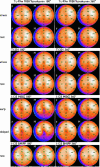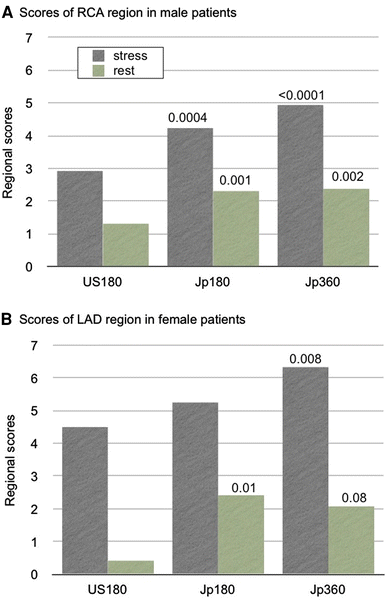Normal values for nuclear cardiology: Japanese databases for myocardial perfusion, fatty acid and sympathetic imaging and left ventricular function
- PMID: 20108130
- PMCID: PMC2855806
- DOI: 10.1007/s12149-009-0337-2
Normal values for nuclear cardiology: Japanese databases for myocardial perfusion, fatty acid and sympathetic imaging and left ventricular function
Abstract
Myocardial normal databases for stress myocardial perfusion study have been created by the Japanese Society of Nuclear Medicine Working Group. The databases comprised gender-, camera rotation range- and radiopharmaceutical-specific data-sets from multiple institutions, and normal database files were created for installation in common nuclear cardiology software. Based on the electrocardiography-gated single-photon emission computed tomography (SPECT), left ventricular function, including ventricular volumes, systolic and diastolic functions and systolic wall thickening were also analyzed. Normal databases for fatty acid imaging using (123)I-beta-methyl-iodophenyl-pentadecanoic acid and sympathetic imaging using (123)I-meta-iodobenzylguanidine were also examined. This review provides lists and overviews of normal values for myocardial SPECT and ventricular function in a Japanese population. The population-specific approach is a key factor for proper diagnostic and prognostic evaluation.
Figures


Similar articles
-
Characterization of Japanese standards for myocardial sympathetic and metabolic imaging in comparison with perfusion imaging.Ann Nucl Med. 2009 Aug;23(6):517-22. doi: 10.1007/s12149-009-0269-x. Epub 2009 Jun 12. Ann Nucl Med. 2009. PMID: 19521747
-
Normal values and standardization of parameters in nuclear cardiology: Japanese Society of Nuclear Medicine working group database.Ann Nucl Med. 2016 Apr;30(3):188-99. doi: 10.1007/s12149-016-1065-z. Epub 2016 Feb 20. Ann Nucl Med. 2016. PMID: 26897008 Free PMC article. Review.
-
Comparison of conventional and cadmium-zinc-telluride single-photon emission computed tomography for analysis of thallium-201 myocardial perfusion imaging: an exploratory study in normal databases for different ethnicities.Int J Cardiovasc Imaging. 2017 Dec;33(12):2057-2066. doi: 10.1007/s10554-017-1205-0. Epub 2017 Jun 29. Int J Cardiovasc Imaging. 2017. PMID: 28664481
-
Diagnostic value of automated quantification of nuclear cardiology in Japanese patients with single vessel coronary artery disease: comparison between Japanese and American normal databases.J Cardiol. 2013 Oct;62(4):224-9. doi: 10.1016/j.jjcc.2013.04.001. Epub 2013 May 31. J Cardiol. 2013. PMID: 23731920
-
The present role of nuclear cardiology in clinical practice.Q J Nucl Med Mol Imaging. 2005 Mar;49(1):43-58. Q J Nucl Med Mol Imaging. 2005. PMID: 15724135 Review.
Cited by
-
Identification of myocardial damage in systemic sclerosis: a nuclear cardiology approach.Int J Rheumatol. 2010;2010:496509. doi: 10.1155/2010/496509. Epub 2010 Aug 31. Int J Rheumatol. 2010. PMID: 20862337 Free PMC article.
-
How do we establish cardiac sympathetic nervous system imaging with 123I-mIBG in clinical practice? Perspectives and lessons from Japan and the US.J Nucl Cardiol. 2019 Aug;26(4):1434-1451. doi: 10.1007/s12350-018-1394-5. Epub 2018 Sep 3. J Nucl Cardiol. 2019. PMID: 30178272
-
Multicenter cross-calibration of I-123 metaiodobenzylguanidine heart-to-mediastinum ratios to overcome camera-collimator variations.J Nucl Cardiol. 2014 Oct;21(5):970-8. doi: 10.1007/s12350-014-9916-2. Epub 2014 Jun 19. J Nucl Cardiol. 2014. PMID: 24942608 Free PMC article.
-
Factors affecting appearance of a normal myocardial perfusion scan.J Nucl Cardiol. 2018 Oct;25(5):1655-1657. doi: 10.1007/s12350-017-0857-4. Epub 2017 Mar 30. J Nucl Cardiol. 2018. PMID: 28361475 No abstract available.
-
New techniques, distinctive population, unique normal databases.J Nucl Cardiol. 2018 Aug;25(4):1338-1341. doi: 10.1007/s12350-017-0876-1. Epub 2017 May 4. J Nucl Cardiol. 2018. PMID: 28474193 No abstract available.
References
-
- Klocke FJ, Baird MG, Lorell BH, Bateman TM, Messer JV, Berman DS, et al. ACC/AHA/ASNC guidelines for the clinical use of cardiac radionuclide imaging–executive summary: a report of the American College of Cardiology/American Heart Association Task Force on Practice Guidelines (ACC/AHA/ASNC Committee to Revise the 1995 Guidelines for the Clinical Use of Cardiac Radionuclide Imaging) Circulation. 2003;108:1404–1418. doi: 10.1161/01.CIR.0000080946.42225.4D. - DOI - PubMed
-
- Tamaki N. Guidelines for clinical use of cardiac nuclear medicine (JCS 2005) Circ J. 2005;69(Suppl. IV):1125–1202.
Publication types
MeSH terms
Substances
LinkOut - more resources
Full Text Sources

